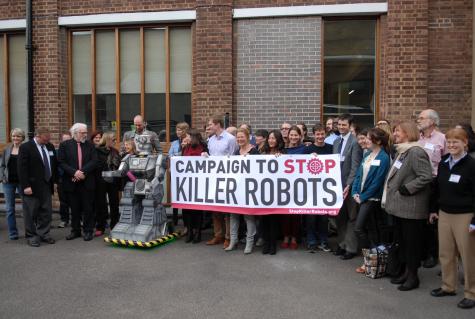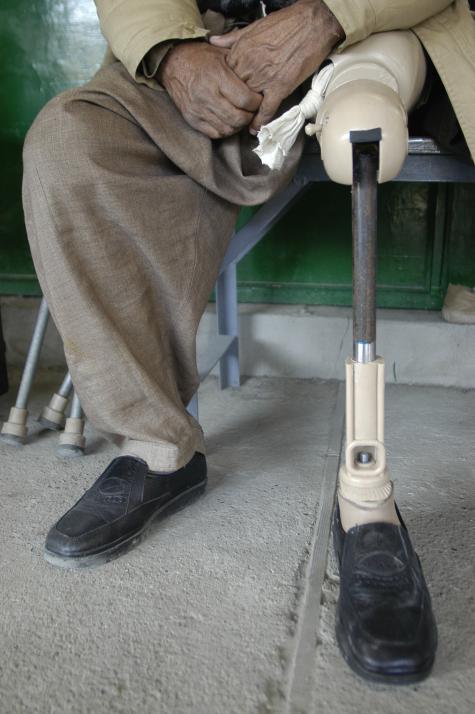WEAPON Systems & Drones

Guide to WEAPON SYSTEMS AND DRONES – Security or Dehumanisation of Warfare?
In a world increasingly driven by technology, the evolution of weapons systems and drones raises urgent questions about the morality, safety, and consequences of expanding militarization. Lightweight surveillance devices, armed remote-controlled weapons, and pilotless aircraft are becoming the first choice for politicians and defence officials.
In this➡️ platform on weapons systems and drones we ask if the use of technology in warfare is ethical, how accurate really are airstrikes, and does this mean the creation of new forever wars? Discover over 1,600 resources including information on killer drones and robots, small arms, depleted uranium weapons, cluster bombs, the Eurofighter, landmines, the use of artificial intelligence in modern warfare, cyberwars, 3D printed weapons, and Future Combat Air Systems.
We also highly recommend our guides to the Military, increasing militarization of countries, the arms trade, and of course our exemplary toolboxes on Peace, Nonviolence, inspiring peace activists, and courageous anti-war organisations. German speakers should head to our partner site Bessere Welt Info for over 850 links on Waffensysteme.
“A drone strike is a terror weapon, we don't talk about it that way. It is; just imagine you are walking down the street and you don't know whether in 5 minutes there is going to be an explosion across the street from some place up in the sky that you can't see. That is a terror weapon. It terrorizes villages, regions, huge areas. It's the most massive terror campaign going on by a long shot.” - Noam Chomsky

Killer Drones – Ethics, Accuracy, and Risk
Over 35 countries around the world now have armed drones. The benefits of their use includes providing ground troops with eyes from the sky, greater precision, and the collection of essential real-time data and intelligence.
The first prototypes of remotely piloted aircrafts appeared in the 1990’s which were used by the U.S military for surveillance. Since then, their capability for destruction has vastly increased with the development of armed killer drones. The deadliest of which is the MQ-9b Sky Guardian, capable of operating for 40 hours, carrying huge payloads of 4,750 lbs, and with a range of 6,000 nautical miles.
The use of armed drones is sold to the public as a risk-free security solution. We are told that this type of technology keeps our armed forces safe, but the reality is that drones and warfare of any kind only serve to create more instability. Killer drones merely transfer the risk of war from soldiers to civilians.
Operated remotely and with no transparency, killer drones dehumanise conflict. The physical distance between armed drone operators and their target makes the act of killing much easier. Politicians and defence officials are distanced from death and destruction, and this quick short-term fix becomes an easy way to ‘destroy the enemy’. Killer drones are a dangerous shift in warfare that prolong violence and distract from solving the root causes of conflict via diplomatic and political means.
Regarding International Humanitarian Law (IHL) and the Laws of War, the targeted killing of combatants is legal. However, outside of IHL situations lethal force may only be used when absolutely necessary to save human lives that are in imminent danger. Outside of active warzones, targeting killing is unequivocally illegal.
Illegal targeted killings by drones have been carried out by the U.S. on multiple occasions in their 20-year Global War on Terror - all with no accountability. These indiscriminate attacks took place in Yemen, Pakistan, Afghanistan, Iraq, Syria, and Somalia - all resulting in the deaths of thousands of civilians.
One risk regarding killer drones is their lack of precision. Even though they may be more accurate than the airstrikes in WWI and II, however, even under test conditions, only 50% of weapons are expected to hit their ‘circular area of probability’ (Drone Wars). This myth of precision is allowing leaders to justify the use of armed drones in civilian areas, which previously would have been out of bounds.
- In 2019, the collateral damage from thousands of drone strikes in Iraq and Syria led to the deaths of 13,000 civilians including 2,300 children.
- The number of civilian causalities from drone strikes in Afghanistan more than doubled from 2018 to 2019.

Killer Robots - Fully Autonomous Weapons
To many peace activists and antimilitarists, killer drones are the precursor to fully autonomous weapons. Killer robots enable the identification and killing of targets without any meaningful human control. This ability to make life or death decisions marks a disturbing trend, and we are potentially on the brink of this new form of modern warfare.
Organisations such as Stop Killer Robots campaign hard to prevent the opening of this Pandora’s box. Despite this, countries including the U.S., China, the UK, India, Iran, Israel, South Korea, Russia and Turkey are all investing heavily into killer robot technology.
Fully autonomous weapons do not meet international humanitarian law standards and would threaten our fundamental right to life. They also would undermine human accountability in conflict. Unchecked proliferation of such technology poses a terrifying risk as humans lose control over the use of force.
Currently there is no treaty to legally prevent countries from investing in autonomous weapons systems. However, there is intense debate worldwide as experts, activists, and politicians weigh up the potential benefits with the enormous risks involved in the use of killer robots, the potential for mistaken identity, and how we could stop them if necessary.

Cluster Bombs and Landmines – A Lasting Legacy
Cluster bombs are incredibly powerful, indiscriminate, and deadly munitions which scatter across vast areas, posing a huge threat to civilians during and long after conflicts. Cluster munitions have a huge fail rate which poses a gigantic humanitarian risk as unexploded submunitions dangerously cover areas the size of several football fields.
The 2010 Convention on Cluster Munitions is an international treaty signed by more than 100 states which bans the use, production, transfer and stockpiling of cluster munitions. The treaty even goes as far as providing victim assistance and the responsibility to clear contaminated areas.
Laos sadly takes the title of the world's most heavily contaminated country, despite being bombed more than forty years ago. The failed sub-munitions are still causing casualties today, the victims of which are very often children.
Despite the ban, in the last 2 years the use of cluster munitions has been recorded in Syria, Yemen, Ukraine, Libya, and Sudan. 16 countries are still believed to produce them including China, Russia, and Israel. 59 countries still stockpile several million submunitions, and although the U.S. has signed the treaty and is no longer a producer, they are still in possession of 3 million submunitions and retain the option to produce more in the future.

Landmines similarly have long-lasting humanitarian consequences. This type of explosive device is designed to detonate on the presence, proximity, or contact of a person. They can lie dormant for decades until their detonation mechanism is activated. Indiscriminate in their nature, landmines are deadly regardless of whether a soldier, a civilian, a child, or an animal comes into contact with it.
The number of undetonated mines in the world is unknown, but it only takes the suspicion of their presence to determine a huge area of land be condemned as unusable. The Mine Ban Treaty which came into effect in 1997 prohibits the use, production, stockpiling, and transfer of mines. It also requires that all stockpiles be destroyed, all mined areas to be cleared, and to provide assistance to landmine victims.
164 states have signed the Mine Ban Treaty and are making progress in achieving the goal of a mine-free world. Notable absentees include the U.S., China, India, Pakistan, Russia, Myanmar, the UAE, Cuba, Egypt, Israel, and Iran.
In the 2 decades since the treaty was adopted millions of dormant landmines have been destroyed. Despite this progress, contaminated land still exists in almost 70 countries where innocent civilians continue to be killed and seriously maimed.
Peace organisations and anti-militarist groups such as the International Campaign to Ban Landmines condemn these weapons for their catastrophic humanitarian consequences and advocate for their complete eradication.

Depleted Uranium Weapons – Toxicity and Radioactivity
Depleted uranium is used to strengthen tank armour and on the tips of ammunition to increase their impact on contact with armour. The damage caused by these types of weapons is further worsened by ignition on impact.
In addition to the immediate harm caused, depleted uranium leaves behind a toxic footprint which endangers future generations and the health of our planet. Discover reliable news sources, organisations fighting against their use and proliferation, tools for campaigners, as well as comprehensive guides on Gulf War and Balkan War Syndrome which were originally linked to the presence of depleted uranium in the environment.

Although less radioactive than naturally occurring uranium, the risk of soil contamination and health implications including birth defects is still too high. As they are not strictly considered a nuclear weapon, there is no treaty which bans their use. Campaigners and activists such as the International Coalition to Ban Uranium Weapons have condemned the export of depleted uranium shells and tank rounds by the UK and U.S. to Ukraine in the war against Russia.
Cyber War and Artificial Intelligence - Digital Battlefields
Cyber wars, while devoid of traditional violence, raises serious concerns about privacy, security, international tensions, and lack of accountability. Our increasingly digitalised world and the interconnected nature with vital infrastructure has left the world vulnerable to cyber threats. Attacks come in the form of hacktivism, identity theft, malware, and on a larger scale, threats to national security. There is an urgent need for international cooperation and collaboration to mitigate these increasingly sophisticated cyberthreats.
In 1999 an American teenager proved just how vulnerable the U.S. Department of Defence is to attack when he installed a backdoor within their servers allowing him to intercept emails, locate passwords and usernames, and even steal NASA software which was being used by the International Space Station.
The use of artificial intelligence in war allows militaries to process information at lighting speed, providing a significant advantage over enemies. Noncombat functions such as in logistics, maintenance, personnel, and finance have their obvious advantages. However, when total human control and decision making is given over to AI on the battlefield, very difficult legal, moral, and ethical questions are raised.

There are many risks associated with the use of AI in warfare. The potential for systems to be hacked or manipulated leaves governments extremely vulnerable. Other factors to consider include lack of human judgement and accountability, the dehumanisation of war, algorithm bias, a new arms race of technology, and the current insufficiency of regulation.
Modern Technology for a Better World
As anti-war and peace activists we must question the wisdom of technologies that detach us from the human cost of war. Better World Info is committed to peace, diplomacy, and disarmament instead - concepts which have become imperative in a world teetering on the brink of major catastrophe.
Whilst we condone the use of technology for death and destruction, we do acknowledge that technology also can be used for good. We question the endless funding into increased militarisation which only serves to perpetuate forever wars and line the pockets of war profiteers. These funds could be used to further advances in peacebuilding, resolve root causes of conflicts, and help finance the implementation of the SDGs.
We must acknowledge the great risks involved in dehumanising conflict. Remote warfare signifies a move to airstrikes initiated with impunity, minimal decisions of conscience, and a greater chance of civilian harm. As high-tech military operators work in secret military facilities, battlegrounds are shielded from the media, and public and political pressure calling for peaceful solutions fades.
“The coming era of Artificial Intelligence will not be the era of war, but be the era of deep compassion, non-violence, and love.”
- Amit Ray
Authors: Hüseyin & Merve 26.10.23 Edited by Rachael Mellor 03.11.23
For further reading on Weapons Systems and Drones see below ⬇️
Info on WEAPON Systems & Drones
- Killer DRONES[344]
- Killer ROBOTS[273]
- SMALL ARMS : 90 % of victims in wars since 1945[25]
- Depleted URANIUM Weapons[507]
- CLUSTER Bombs[102]
- EUROFIGHTER[175]
- LandMINES[156]
- CYBER War[112]
- LASER Weapons[9]
- ARTIFICIAL Intelligence - AI[439]
- Dark Eagles / Hypersonic Missiles[8]
- Articles on weapons in general[14]
- Future Combat Air System - FCAS[19]
- Next Generation Air Dominance - NGAD[1]
- Printable Gun[31]
- JASSM Rapid Dragon[4]